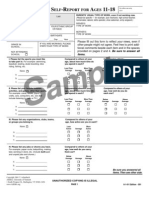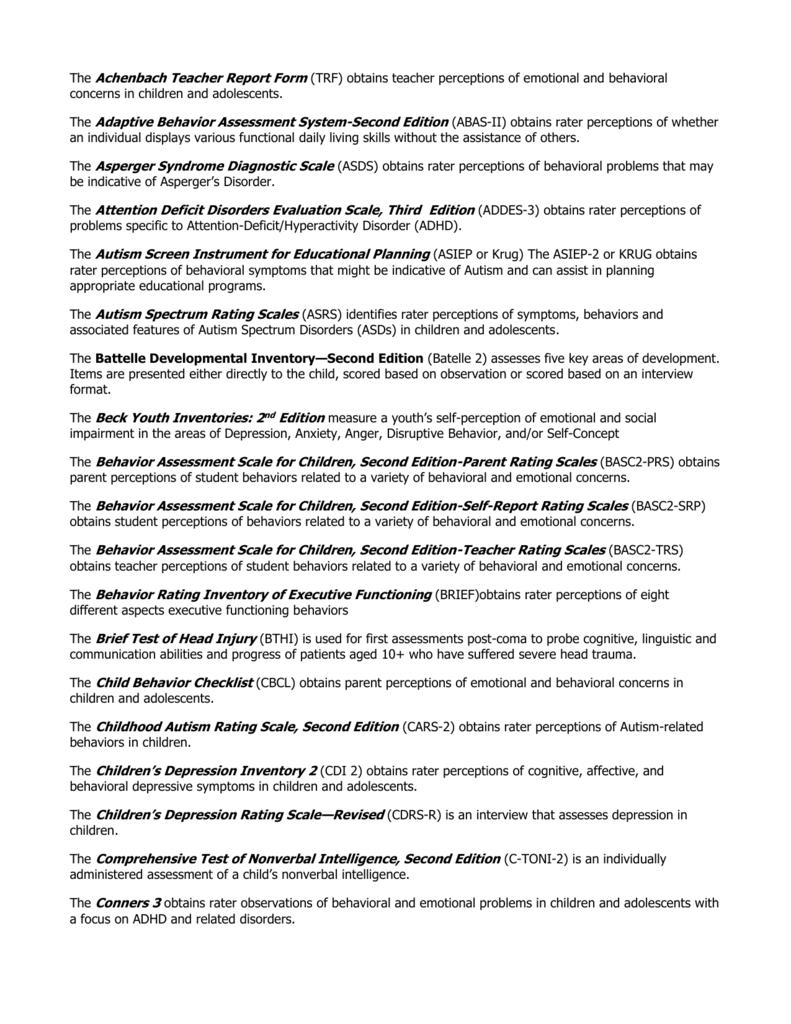
Beck Youth Inventories (BYI)


Beck Anxiety Inventory (BAI) About: This scale is a self-report measure of anxiety. Items: 21 Reliability: Internal consistency for the BAI = (Cronbach’s α=0.92) Test-retest reliability (1 week) for the BAI = 0.75 (Beck, Epstein, Brown, & Steer, 1988). Validity: The BAI was moderately correlated with the revised Hamilton. R = 0.48 with the Beck Anxiety Inventory (160 patients) (Beck et al., 1988) r = 0.71 with the Revised Hamilton Psychiatric Rating Scale for depression Illness involving the body, mood, and thoughts, that affects the way a person eats and sleeps, the way one feels about oneself, and the way one thinks about things.
Beck Youth Inventory Combination Booklet

Beck Youth Inventory 3

Beck Youth Inventory Scoring
BECK YOUTH INVENTORIES (BYI) | |
Sources | Beck Youth Inventories- For Children and Adolescents 2nd Edition (BYI-II). (2011).Retrieved from: http://www.cup.ualberta.ca/wp-content/uploads/2012/06/FINAL_BYI-II_Jan-2012.pdf |
Beck Youth Inventories- Second Edition. (2012). Retrieved from: http://pearsonassess.ca/haiweb/Cultures/en-CA/Products/Product+Detail.htm?CS_Category=&CS_Catalog=TPC-CACatalog&CS_ProductID=015-8014-197 | |
Measure Profile: Beck Youth Inventories (BYI). (2012). Retrieved from: http://www.excellenceforchildandyouth.ca/support-tools/measure-profile?id=335 | |
Evaluation Methodology | “This instrument can be used as a measure of self-concept and psychological well-being in children and adolescents, as a measure to identify children and adolescents in need of further intervention or evaluation, and as an assessment of symptom severity” (Measure Profile, 2012). |
Measurement Characteristics | |
Purpose | “This instrument is intended to provide a broad assessment of a child or adolescent’s current mental health. The individual inventories may also be used in isolation to assess specific aspects of child and youth mental health. It is NOT a diagnostic instrument“ (Measure Profile, 2012). |
Description | 100 self-reported or verbally administrated items(Measure Profile, 2012). |
(sub) Scales | 5 inventories (depression, anxiety, anger, disruptive behavior, and self-concept) with 20 questions each(Measure Profile, 2012). |
Target Population | Children and adolescent ages 7-18. |
Psychometric Properties | “1,278 children and adolescents ages 7-18 from the U.S. Sample was reflective of U.S. population demographics” (Measure Profile, 2012). |
“The authors report internal consistency (alpha) coefficients ranging from 0.86 to 0.96, and test-retest reliability correlation coefficients ranging from 0.74 to 0.93. Another study found alphas of 0.87 to 0.92, and test-retest coefficients that were all greater than 0.70” (Measure Profile, 2012). | |
“The BYI-II manual discusses three kinds of reliability that were studied using the general population normative samples:
“Test-retest Reliability: A sub-sample (105 individuals) of the general population samples were retested with the BYI-II approximately one week after the first administration. The test-retest reliabilities were calculated, and yielded correlation coefficients in the ranges of .74 to .90 for ages 7-10, .84 to .93 for ages 11-14, and .83 to .93 for ages 15-18. In general, test-retest reliabilities were the same for both males and females. “Standard Error of Measurement and Confidence Intervals: The manual also discusses the degree to which measurement error contribute to an individual’s observed score. According to the manual, average standard error of measurement coefficients ranged from 2.12 to 3.37 depending upon scale and age group” (Beck Youth Inventories- For Children and Adolescents 2nd Edition (BYI-II), 2011). | |
“The authors report evidence of good concurrent validity for each of the individual inventories (except the anger inventory) with measures of those constructs (e.g., the depression inventory with the Children’s Depression Inventory), and discriminative validity. A further study found that while the BYI could differentiate between clinical and non-clinical samples, it was bit able to reliably discriminate between internalizing disorders, with the exception of depression” (Measure Profile, 2012). | |
“Convergent Validity: The BYI‐II manual discusses several validation studies that were conducted. The first study compared the BYI‐II to the Children’s Depression Inventory (CDI) using a subsample of 128 children ages 7‐14. According to the manual, the BYI‐II depression scale was correlated at .72 with the total score of the CDI scale, suggesting that the tools measure degrees of depression similarly. The authors also used a sub‐sample of 26 youth (ages 15‐18) whose scores yielded an averaged correlation coefficient of .67 between the BYI‐II depression scale and the CDI total score. “The second study compared the BYI‐II Anxiety Inventory (BAI‐Y) to the Revised Children’s Manifest Anxiety Scale (RCMAS). A sample of 192 children (ages 7‐14) yielded averaged correlation coefficients of .70; a sample of 35 adolescents yielded an averaged correlation coefficient of .64. “The third study compares the BYI‐II Disruptive Behavior Inventory (BDBI‐Y) to the Conners’ Rating Scales‐Revised Adolescent Self‐Report [Short] (CASS‐S) using a sub‐sample of 108 children (ages 12‐14) and 89 adolescents (ages 15‐18). Disruptive Behavior scale scores for the child sample correlated .69 with the Conduct Problems scale, while the same scales correlated .76 for the adolescent sample. “A fourth study compared the BYI‐II Self‐Concept inventory to the Piers‐Harris Children’s Self‐Concept Scale (PHCSCS). A sub‐sample of 105 children ages 8‐14 yielded scores that correlated .61 between both scales. The study was replicated using a sub‐sample of 49 adolescents, yielding an average correlation coefficient of .77 between both scales. “Group Differences: The authors also demonstrate that the tool is able to discriminate between groups who have been identified as having higher levels of distress from groups who have been identified as having lower levels of distress. The results from a multivariate analysis comparing a sample of 88 children that were receiving special education services with a matched sub‐sample of the general population group indicated that the BYI‐II “significantly differentiated distress expressed by special education students from that expressed by a matched control group in regular education” (manual, p. 50). “Similarly, the scores of a clinical sample of 107 children were compared with a matched subsample from the general population group. According to the manual (p. 51), ‘scores of three of the Beck Youth Inventories [Self‐Concept, Disruptive Behavior, and Anger] were significantly different for the outpatient group and the matched control group.’ “The manual also includes other differential analyses that demonstrate the tool’s ability to differentiate between clinical groups that are not discussed here.(Beck Youth Inventories- For Children and Adolescents 2nd Edition (BYI-II), 2011). | |
Administration Factors | “5-10 minutes per inventory; 30-60 minutes for full scale”(Measure Profile, 2012). |
“Scoring and interpretation requires a doctorate in psychology, education, or a related field with relevant training and experience in assessment, or a license to practice in a health or allied health care field (e.g. doctors, nurse practitioners, social workers, etc.)” (Measure Profile, 2012). | |
Languages | English, Danish, French and Polish (Measure Profile, 2012). |
Availability of Measure | Available from Pearson: http://pearsonassess.ca/haiweb/Cultures/en-CA/Products/Product+Detail.htm?CS_Category=&CS_Catalog=TPC-CACatalog&CS_ProductID=015-8014-197 |
Pros | “Inventories are written at a second-grade reading level and may be read aloud to those with reading difficulties” (Beck Youth Inventories- Second Edition, 2012) |
Cons | “Scoring and interpretation requires a doctorate in psychology, education, or a related field with relevant training and experience in assessment, or a license to practice in a health or allied health care field (e.g. doctors, nurse practitioners, social workers, etc.)” (Measure Profile, 2012). |
Expensive. Combination Inventory Booklets are $250 for 25 packages, with each of the individual Inventories costing $83 for 25 packages (Beck Youth Inventories- Second Edition, 2012) | |
“Training required for verbal administration” (Measure Profile, 2012) | |